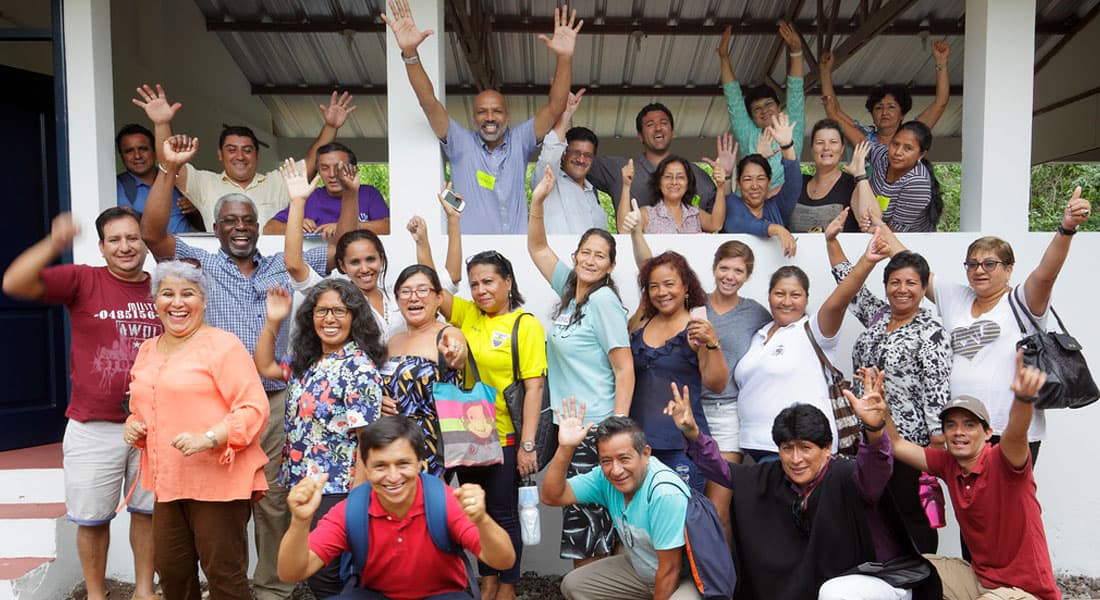
11 May Galápagos Goes Global
Written by Brittany Lenhart, T2T-I Intern, N.C., U.S.
How does a soon-to-be graduate of an International Education program finish up her degree in the best way possible? Let me share with you the answer: she travels to the Galápagos Islands to work with local teachers.
This past April, Galapagueño teachers participated in a five-day professional development institute organized by the Galápagos Conservancy. As an intern with Teachers2Teachers-International (T2T-I), I had an intimate view of everything that went on in the math subject area.
You probably won’t be surprised to hear that I consider this trip precious. Join me on this amazing adventure, as I try to recreate the experience.

Upper elementary teachers celebrate after their workshop led by Arthur Powell and Lawrence Clark on Santa Cruz island in the Galápagos
Background
First of all, if you want to get a sense of what was accomplished during this trip, context is crucial. Historically, many local teachers are taught to teach using lectures and rote memorization, bypassing independent thought, active learning, or new approaches based on how young people learn.
We know for a fact that traditional teaching practices are widespread; however, further complicating innovative teacher training and professional development programs in the Galápagos Islands is their remote location.
Thanks to technological advances and the internet era, Galápagos is waving good-bye to their isolation and welcoming globalization with open arms. That’s how T2T-I enters the equation!

T2T-I math advisory team members at Los Gemelos volcanic craters on Santa Cruz island in the Galápagos (Brittany is second from right)
Kickoff
On the first day, the entire group of 130 teachers and 30 trainers gathered in the auditorium, where the amount of energy filling the room was really high. Part of the excitement came from the U.S. based teachers, who had spent months preparing for these workshops, and part of the excitement originated from the Ecuadorian teachers, who had been waiting, for years in some cases, for a chance to develop 21st-century classroom skills.
The project took off with the introduction of the U.S. based teachers, a survey for the Ecuadorian teachers and the agenda for the week.
Over the next five days it was my pleasure to assist in the delivery of multiple workshops with a number of presenters.

Diego Roman leads a science workshop for teachers at the Tomás de Berlanga School on Santa Cruz island
Workshops
The first workshop I observed was led by two of the U.S. trainees: Tim Erickson, a retired math teacher, and Chadd McGlone, T2T-I Executive Director. During their presentation, they asked local high school mathematics teachers these questions:
What memories do you have of learning math in school?
Is math something you do alone or together?
The trainers pointed out that in the world today, people collaborate all the time and everywhere. Being able to work with others on mathematical tasks is a skill that will benefit students in many ways.
During the opening activity, as the teachers sat in small groups of 4 or 5, they each received a piece of information about a math problem. For example, one teacher might know that the road was 20 km long, while another might learn that the bus can hold 35 students. In order to solve the problem, they had to work together.

Scenes from math and science workshops at the Tomás de Berlanga School, featuring Lawrence Clark, Diego Roman, and Arthur Powell (l to r)
When a group finished, Tim or Chadd would talk with them about the different strategies they could use when something like this happens in their classrooms. Tim offered this suggestion:
As the teacher, I can walk around the room and see what the groups are using, what strategies. This way, I don’t need to explain every strategy. I can ask a student to show another group the strategy they came up with. Students may benefit more from hearing the explanation from a fellow student.
The session ended with a discussion about applying in their own classrooms what they experienced about group work during the workshop.
Collaboration
Throughout the next four days the Ecuadorian teachers wholeheartedly engaged in the workshops, offering their perspectives and knowledge, asking questions, and trying out new learning tools. I am happy to say that by the final day of the workshops, I saw that collaboration was not just a word, it was a practice.

Scenes from math workshops at the Tomás de Berlanga School, featuring Chadd McGlone, Tim Pope, and Lawrence Clark (l to r)
Building Relationships
As the week closed with another gathering of the entire group, I overheard many teachers offer invitations for the trainers to come back and continue their work together. I feel fortunate to be involved in this four-year project, because as exciting and monumental as this first installment was, its goals can only be reached with further collaboration. The relationships we built last week will be the springboard for this project to evolve into a real educational gem.

Galápagos math and science teachers gather at the community center in Puerto Ayora, Santa Cruz
No Comments